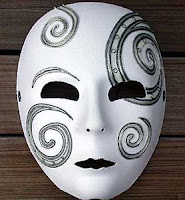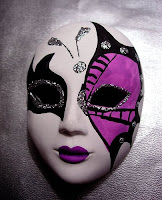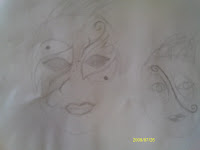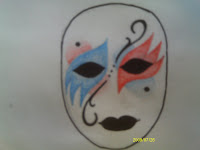
I found the first mask by searching ritual masks. I think it intrigues me because of the disheveled feathers atop it. In a traditional mask, there would be a line of feathers, symmetrical, and neatly placed. I wonder if they were originally placed unorganized and bent, or if they were neat to begin with, and got destroyed over time.
The mask has a golden color, and appears old and worn out. Atop the head is the pile of feathers from a light golden color to a dark brown. It has normal facial features; two eyes, two ears, a mouth and a nose, and a pointed chin. I think the point of the chin leads you upward around the face and to the feathers, which lead your eye to the right, away from the face. The golden color makes the mask appear important and rich.

I came across the second mask in a Google search for masks. I enjoyed the simplicity of the mask, and the lack of symmetry between the sides.
I plan to include those features in my mask, hopefully using the swirls in the piece as movement throughout the whole piece.
The mask has a white base color, and details done in gray and black. The eyes of the mask are blacked out, as well as the lips, which gives it a mysterious look, and almost an evil eye. On the left, below the eye there is a medium sized swirl, along with a small one in the lower right and upper left, and a large swirl in the upper right, which goes through the eye. Above the left eye, there is part of a swirl, which appears as an eyebrow. There are two small holes as nostrils at the bottom of the nose, and two circles on the sides of each eye as well. Although their is movement among the swirls themselves, your eye is drawn to the deep darkness of the eyes as a focal point.

Like the last mask, this one is also unsymmetrical. I chose it because of its feminine qualities and the contrast between the two colors used. I will use two to three colors in my mask, and possibly glitter as well.
The base of the mask is white, with black and purple details. Around the left eye, there is a black patch, with flares outward towards the edge of the mask. Directly around the eye there is a line of glitter. The right side is similar, but on a larger scale. The shape is repeated, outlined in black, but filled in with a medium purple color. In the black outline, there are glitter dots. The lips of the mask are purple, and in the center of the forehead there is a circle of glitter, with two shapes coming off from it, which look similar to antennas. There is a good balance in the mask. Although the left hand side has a smaller design than the right, th
e left side is heavy because of the darkness of the black, and balances out the large shape on the right.

My goal was to make a mask that was simple, unified, and had feminine characteristics. In my initial sketches, I had planned to make hair on the head, but I thought it looked prettier and more feminine without it. I also planned to make the lips red, which I did, then covered in black because it made the picture off balanced with the red from the right eye and the lips so close together. I wanted it to be balanced, but not symmetrical, so I did that by doing mirror images between the two eyes. I wanted the colors to be contrasting, but not complementary colors.

In my final piece, I incorporated the swirls from the second mask, and the shapes around the eyes from the third. I colored the eyes in black, and put shapes around them. The left one was blue, and the right one was right. Then I decided to put black dots at the inner curve part of each shape, above the left eye and below the right eye. To bring that together as part of the eye shape, I made ovals from the top to the bottom of each eye, and shaded them in the opposite color, fading out as they went past the black circles. By the shading, and fading of the red and blue, I think I achieved the femininity I was looking for. It makes it softer, and more playful than if they were shaded in bold red and blue. On the outer curve of each eye, I made a swirl shape, leading you away from the eye, and curling towards the center of the face. Between the eyes, at the start of the swirls, there are three dots, which I find to be the focal point of the piece, even though they are the least pronounced. The black of the eyes and lips are dominant, and bring your eye in to the center of them, then the swirls lead that way, and my eye stops at those three little dots.
I enjoyed the process. The first sketch I made in my sketchbook was actually my favorite one, so I made a few minor changes to it, and created my final piece. I found it more difficult finding the inspiration pieces. I liked a lot of masks for different reasons, but they were all so unique, I didn't know how I would tie the three of them together into one final piece. Actually coloring the mask once I had my idea was fun. I haven't used colored pencils in a while, and forgot how much I love them.





























